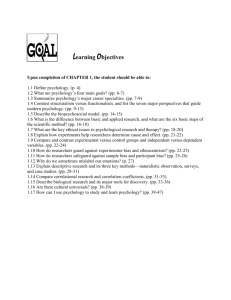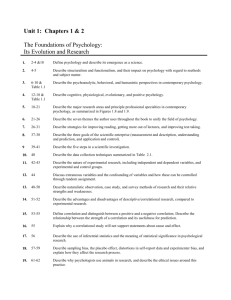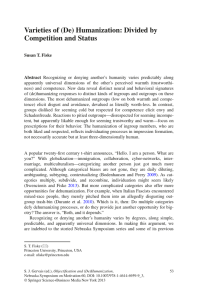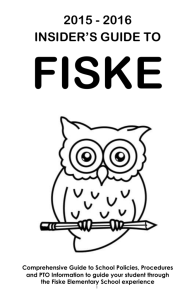Reading Questions
advertisement
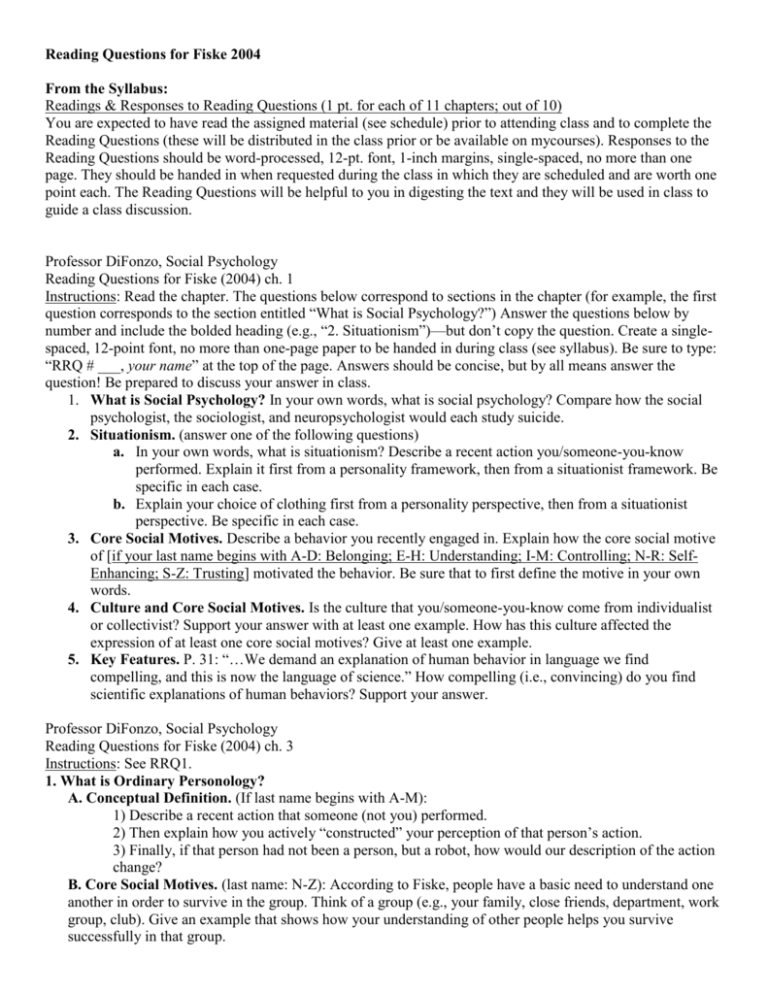
Reading Questions for Fiske 2004 From the Syllabus: Readings & Responses to Reading Questions (1 pt. for each of 11 chapters; out of 10) You are expected to have read the assigned material (see schedule) prior to attending class and to complete the Reading Questions (these will be distributed in the class prior or be available on mycourses). Responses to the Reading Questions should be word-processed, 12-pt. font, 1-inch margins, single-spaced, no more than one page. They should be handed in when requested during the class in which they are scheduled and are worth one point each. The Reading Questions will be helpful to you in digesting the text and they will be used in class to guide a class discussion. Professor DiFonzo, Social Psychology Reading Questions for Fiske (2004) ch. 1 Instructions: Read the chapter. The questions below correspond to sections in the chapter (for example, the first question corresponds to the section entitled “What is Social Psychology?”) Answer the questions below by number and include the bolded heading (e.g., “2. Situationism”)—but don’t copy the question. Create a singlespaced, 12-point font, no more than one-page paper to be handed in during class (see syllabus). Be sure to type: “RRQ # ___, your name” at the top of the page. Answers should be concise, but by all means answer the question! Be prepared to discuss your answer in class. 1. What is Social Psychology? In your own words, what is social psychology? Compare how the social psychologist, the sociologist, and neuropsychologist would each study suicide. 2. Situationism. (answer one of the following questions) a. In your own words, what is situationism? Describe a recent action you/someone-you-know performed. Explain it first from a personality framework, then from a situationist framework. Be specific in each case. b. Explain your choice of clothing first from a personality perspective, then from a situationist perspective. Be specific in each case. 3. Core Social Motives. Describe a behavior you recently engaged in. Explain how the core social motive of [if your last name begins with A-D: Belonging; E-H: Understanding; I-M: Controlling; N-R: SelfEnhancing; S-Z: Trusting] motivated the behavior. Be sure that to first define the motive in your own words. 4. Culture and Core Social Motives. Is the culture that you/someone-you-know come from individualist or collectivist? Support your answer with at least one example. How has this culture affected the expression of at least one core social motives? Give at least one example. 5. Key Features. P. 31: “…We demand an explanation of human behavior in language we find compelling, and this is now the language of science.” How compelling (i.e., convincing) do you find scientific explanations of human behaviors? Support your answer. Professor DiFonzo, Social Psychology Reading Questions for Fiske (2004) ch. 3 Instructions: See RRQ1. 1. What is Ordinary Personology? A. Conceptual Definition. (If last name begins with A-M): 1) Describe a recent action that someone (not you) performed. 2) Then explain how you actively “constructed” your perception of that person’s action. 3) Finally, if that person had not been a person, but a robot, how would our description of the action change? B. Core Social Motives. (last name: N-Z): According to Fiske, people have a basic need to understand one another in order to survive in the group. Think of a group (e.g., your family, close friends, department, work group, club). Give an example that shows how your understanding of other people helps you survive successfully in that group. 2. Non-Verbal Behavior 1: Conceptual Definition A. (last name A-M): Why do you think women are “somewhat more non-verbally expressive than men? B. (last name N-Z): Do you agree with the hypothesis that colder temperatures lead people to wear bulkier cloths which then dampen nonverbal expression? How could you experimentally test the idea that wearing bulkier clothes dampens nonverbal expression here at RIT? (what would be the IV and the DV?) 3. Non-Verbal 2 A. Proxemics. (last name A-I): Give an example of when you/someone-you-know violated the “shared, unwritten understanding of personal space and territory.” Describe your reaction, both verbal and nonverbal. B. Deception. (last name J-R): Think of times you have lied. What non-verbal behaviors did you exhibit that signified you were lying? In other words, if other people had known about these behaviors, they would have successfully detected your deception (perhaps they did). C. Attraction. (last name S-Z): What non-verbal behaviors do you send to communicate “emotions and impulses” to 1) approach others, and 2) avoid others? (Be prepared to demonstrate in class). 4. Attribution of Dispositions 1 A. (last name A-M): Consider poor immigrants who came to the US but who are no longer poor; why did they succeed? First give a dispositional answer, then a situational one. B. (N-Z): Respond to Fiske’s statement: “conservative political beliefs correlate with dispositional attributions.” 5. Attribution of Dispositions 2 A. Jones Correspondent Inference Theory (last name A-G): Some Chinese nationals have freely expressed their religious views and organized small religious communities; as a consequence, they have been repeatedly sanctioned or arrested by the Chinese government (the Chinese government, officially communist, likes to keep a close tab on religious organizations). Using correspondent inference theory, explain why these Chinese nationals continue to express these views. B. Kelley’s Covariation Model (H-M): Analyze an action you performed using Kelley’s Covariation Model. C. Bem’s Self-Perception Theory of Attitudes (N-S): Suppose someone (your parents, spouse, Oprah Winfrey) agreed to pay you for good grades on your report card. How would this affect inferences you made about yourself? D. Schachter’s 2-Factor Theory of Emotion (T-Z): Describe “the strategy of taking one’s date to a roller coaster or a thriller movie.” 6. Errors & Biases in Attribution A. (A-M): Fiske states that dispositional bias is adaptive and it serves core social motives of understanding and control. But if indeed other people are as unpredictable as we are, how could the bias toward attributing dispositional causes to behavior be adaptive? In other words, wouldn’t our biases lead us to inaccurate attributions about other people and, over time, this attributional bias would “die off?” B. (N-Z): If the self-serving attribution bias is “not adaptive in the long run” (p. 118), why has it survived? Professor DiFonzo, Social Psychology, Reading Questions for Fiske (2004) ch. 4, Instructions: See RRQ1. 1. What is Social Cognition? A. (If last name begins with A-I): What’s the difference between Personology and Social Cognition? B. (last name: J-R): What would the results of the study described in Table 4.1 look like if perceivers did NOT contribute at all to their own perceptions? (Propose 3 percentages & support your answer). C. (last name: S-Z): If you know someone who is “too trusting,” why do you think this people lacks vigilance? If you know someone who does not trust enough, why do they have too much vigilance? 2. Accuracy: People seek good-enough understanding. A. (A-I): Can you generally size people up in 30 seconds? Give an example of when your first impression has proven accurate and another example of when it proved inaccurate. B. (J-R): How can first impressions generally be accurate if peoples’ behavior is strongly affected by the situation (situationism)? For example, have you ever met someone you thought was shy but they acted extroverted later? (or vice-versa?) C. (S-Z): Give an example of when you committed one of the common inferential biases listed in Table 4.4 (explicitly name the bias, define it, and be sure that your example illustrates it. 3. Accuracy 2 A. (A-M): Give an example of when you used one of the heuristics listed in Table 4.5 (explicitly name the heuristic, define it, and be sure that your example illustrates it. B. (N-Z): Table 4.6 shows how the original Wason 4-card problem was recast in a more appropriate social context—and people performed much better. Recast the Linda Problem (“Which is more likely?: a. Linda is a bank teller or b. Linda is a bank teller and active in the feminist movement) on p. 136 in a more appropriate social context. Try your new problem out on at least four people and see if they exhibit the conjunction error. Remember to ask them: Which is more likely?: a. [the more inclusive option], or b. [the less inclusive option that is more similar to (representative of) the description]. 4. Schemas and expectations A. (A-M): Table 4.7 summarizes several ways that people create coherent impression of others, even when their traits do not obviously fit together. Think of someone you know and explain how you have used one of the “modes of resolution” to create a coherent impression of the person. Be sure to describe the two traits that do not obviously fit together and how you used the “mode of resolution” to make them cohere. B. (N-Z): Use Anderson’s averaging model to calculate an overall impression of a person in a particular context along the two general trait dimensions of likeability and competence. Give each dimension a weight (wi) between 0.00 and 1.00 (be sure that your weights sum to 1.00), assign a score (si) to the person for each dimension on a scale from 1 to 10, then calculate the weighted average for this person ∑wisi = (w1s1) + (w2s2). Does this weighted average tend to match your overall impression of the person in that particular context? 5. Schemas and expectations 2 A. (A-M): Describe a role you play in a given context right now (e.g., employee in your job, student in your class, young adult in your family). Imagine yourself in a radically different role n that context (e.g., you are promoted to director in your workplace, you become the professor of the class, you become the guardian of your family). How would your pattern of behaviors change? Do you think that others might conclude you had a different set of traits or even a different personality and if so, what would those traits/personality be? B. (N-Z): In general, how do you think anxiety affects one’s reliance upon schemas in making a social judgment? Give an example. 6. Goals, automaticity and control A. (A-G): Describe a particular social judgment that has become automatic for you (e.g., the panhandler judgment of how generous a passerby is). Describe how it became automatic for you. B. (H-S): Ask a friend to memorize the words reckless, conceited, aloof, and stubborn, then to read the Donald paragraph on p. 161, then to rate Donald on likeability (“How generally likeable do you find Donald: more positive than negative, or more negative than positive?”) Record your result and we’ll compile in class. C. (T-Z): Do the thought suppression (white bear) exercise in the last paragraph of p. 162. Record the results for compiling in class. Professor DiFonzo, Social Psychology, Reading Questions for Fiske (2004) ch. 5, Instructions: See RRQ1. 1. What is the self? Who are you? Answer (using the following headings) in terms of your a) body/material self, b) inner/spiritual self, c) interpersonal/social self, d) societal self, e) chronically accessible constructs, and f) multiple identities. 2. Self concept: Understanding self. A. (A-I): Describe one way in which you have a complex sense of self; give an example of this. B. (J-R): How did you get to know yourself? Give an example of this process and categorize it as one of the four ways Fiske describes (self-perception of behavior, introspection, social comparison, social feedback). C. (S-Z): Give an example from your life, someone you know, or a fictional character (movie, book, etc.) where self-verification motives were in conflict with self-enhancement motives. How was the conflict resolved? 3. Self concept: Understanding self 2. Score yourself using Table 5.6 (rate each item on a l (strongly disagree) to 7 (strongly agree) scale, reverse score the * items, then sum. Record your score, and whether you are from a European/ European-American (more individualist) culture or a Non-European/Non-European-American (more collectivist) culture. 4. Self concept: Understanding self 3. Think of and/or ask someone you know from a culture different than your own (if you are from an individualist culture, ask a collectivist; if collectivist, ask an individualist): How do they think of themselves? How (if at all) does this differ from how you think of yourself? Do you differ in self-definition, self-structure, life-task, role of others, or self-enhancement vs. self-sympathy? Give a concrete example of how this difference manifests/manifested itself. 5. Self and emotion: Enhancing self A. (A-G): Are you relatively more promotion focused, prevention focused, or equal shares of both? Support your self-assessment and give a concrete example that typifies your focus. B. (H-S): Why can’t there be more than one “family piano player”? That is, why would a sibling piano player cause you discomfort? (the answer to this is not given in the text). C. (T-Z): Give an example of when you (or someone you know) ended up feeling better about a significant failure/negative-event than you thought you would. Why the discrepancy? 6. Self and Behavior: Wanting to belong. Give an example of a time when you (or someone you know) selfpresented as (A-E) likeable, (F-J) competent, (K-O) intimidating, (P-S) saintly, or (T-Z) helpless. Describe the situation, what you did to present yourself in this way, and were you successful. Professor DiFonzo, Social Psychology, Reading Questions for Fiske (2004) ch. 6, Instructions: See RRQ1. 1. What are attitudes? Describe a complex and/or ambivalent attitude that you hold. Support your categorization of the attitude (as complex and/or ambivalent) using concepts from the Conceptual Definitions section; Be sure to include affective, cognitive, and behavioral correlates in your answer. Which (if any) core social motives does the attitude you described serve for you? In addition, which (if any) attitude functions does it serve? Support your answers. 2. How attitudes form via affect first. Give and example of an attitude that You Or Someone You Know (YOSYK) acquired through A. (A-G) classical conditioning, B. (H-M) instrumental conditioning, C. (N-S) modeling, and D. (T-Z) vicarious conditioning. Caution: Be aware of the difference between A and C, and between B and D. A involves a UCR initially, whereas C involves a CR initially. B involves consequences directly experienced by the actor, whereas D involves observing someone else experiencing the consequence. 3. Attitude change via discomfort with contradiction. Describe a time when YOSYK experienced cognitive dissonance. What were the dissonant cognitions or behaviors? Did it involve a free choice? Did it involve effort to obtain a desired goal? Using Fiske’s terms, how did/do you resolve the dissonance? Is “dissonance” another word for “guilt”? Support your answer. 4. Attitude change via understanding: Persuasive communication 1. Describe an incident where someone attempted to persuade you (someone you know, a speaker or teacher someone on TV or radio, etc.) using a fear appeal. Describe the credibility of the source (expertise and trust). Describe the extent to which the person appealed to fear. Did you experience low, moderate or high levels of fear? Was the persuasive attempt successful? What part did fear play in your thinking? 5. Attitude change via understanding: Persuasive communication 2. Choose a magazine/newspaper advertisement (cut it out and append it using a staple—no porn please). Look at the ad. To what extent is the topic/decision pertaining to the ad important or involving to you personally? Using ideas from the Dual Process Model section, how should this affect your processing of the ad? Did it in fact affect your processing in this way? Be sure to touch upon source, message, context, and recipient characteristics. 6. When and Why attitudes matter: Predicting behavior via understanding & belonging. Think of an instance where YOSYK’s attitude did not match YOSYK’s behavior. State the attitude and the behavior. Explain the disconnection. Be sure to address measurement, moderating variables (e.g., strength of attitude), situational norms, self-monitoring, and need for cognition. Professor DiFonzo, Social Psychology, Reading Questions for Fiske (2004) ch. 7, Instructions: See RRQ1. 1. Attraction in daily life and in science. In what way(s) is an attraction like an attitude? In what ways is it not like an attitude? Support your answers. 2. Familiarity. Consider a good friend of yours. How do you think mere exposure and proximity affected the initial liking you had for your friend? Support your answer with an example. 3. Physical attractiveness. Contrast the social lives (i.e., the quality and quantity of social interactions, especially initial social interactions) of two people you know, one of whom is good-looking, the other—not good-looking (no names please). Do your observations agree with the physical attractiveness effects discussed by Fiske in this section? Give at least one example. 4. Similarity. A) Are you attracted to those who are similar to you? Why or why not? Give an example of this. B) If “similars attract” than why does the old adage “opposites attract” survive? 5. Reciprocity. A) From a book, story, movie, or from experiences in your own or someone else’s life, give an example of the reciprocity principle. Classify this example as direct reciprocity, reciprocal liking via good mood, or reciprocal liking via rewards. B) Which is more plausible to you and why: the evolutionary perspective on gender differences in mate preferences or the social structure perspective on gender differences in mate preferences? 6. Chapter Summary. Thoughtfully respond to Fiske’s advice on maximizing attraction (your thoughts please). Professor DiFonzo, Social Psychology, Reading Questions for Fiske (2004) ch. 8, Instructions: See RRQ1. 1. What is a close relationship? Describe a close relationship that someone you know has with another person (no names please). Classify the type of love according to Sternberg’s triangular theory (see Table 8.1) and support your classification. 2. Interdependence 1. Describe an actual example of accommodation you have witnessed in a committed couple. How do you think the person who accommodated accomplished this difficult task? 3. Interdependence 2. Describe a couple (no names please) who you feel mishandles conflict. Describe the pattern according to concepts presented in Fiske and support it with an example. 4. Attachment. Describe someone you know (or a character in a book, movie, etc.) that has an (A-L) anxious or (M-Z) avoidant attachment style. Give an example to support your classification (and be prepared to play-act how this person behaves). How did they get this way? If you have information on their childhood relationships: Describe, in general, how warm, supportive and responsive their primary caregiver (usually their mother) was. Give an example of this. 5. Social Norms. Thoughtfully respond to Fiske’s section on communal and exchange relationships (Don’t summarize—I’m interested in your cognitive and affective reactions to these ideas). Professor DiFonzo, Social Psychology, Reading Questions for Fiske (2004) ch. 9, Instructions: See RRQ1. 1.What is Prosocial behavior? Describe a Prosocial act that YOSYK performed. Explain the intent of the action, and the core social motivations behind the act. Also explain why you think it benefited others. 2. Egoism Hypotheses. Explain the act in question 1 from an egoistic perspective. Touch upon all of these ideas: kin selection, social learning, and mood protection. 3. Altruism Hypotheses. Explain the act in question 1 from an altruism perspective. Touch upon all of these ideas: attribution of responsibility, and empathy. 4. Collectivism Hypotheses. Explain the act in question 1 from a collectivism perspective. Touch upon all of these ideas: similarity and group identity, norms, and individual differences in group Prosocial orientation. 5. Principlism Hypotheses. Explain the act in question 1 from a principlism perspective. Touch upon all of these ideas: moral reasoning, moral rationalizations, and values. Professor DiFonzo, Social Psychology, Reading Questions for Fiske (2004) ch. 10, Instructions: See RRQ1. 1. What is Aggression 1? Describe an aggressive act that YOSYK performed. Explain the intent of the action, and the core social motivations behind the act. Classify it according to Buss’s taxonomy in Table 10.1. 2. What is Aggression 2? Fiske reviews evidence that strongly links aggression with media violence, weapons, and alcohol. Your (intelligent) thoughts on each of these links please (don’t summarize—list your thoughtful reactions, comments, etc.). 3. Cognitive Theories of Aggression 1. Explain the act in question 1 using the ideas of social learning, aggression scripts, and cognitive neo-association theory (touch on all three please). 4. Cognitive Theories of Aggression 2. Explain the act in question 1 using the ideas of hostile attribution bias and excitation transfer (touch on both please). 5. Interpersonal Conflict. Describe an aggressive act that you witnessed (either real or fictional, e.g., on TV) that functioned to control another person in the following ways: A-H: frustration-aggression hypothesis, I-P: bullying, and S-Z: battering. Be sure to touch upon the ideas presented in each of these sections. 6. Protecting one’s image. Describe an aggressive act that you witnessed (either real or fictional, e.g., on TV) that functioned to protect one’s image in the following ways: A-M: Narcissistic rage and N-Z: culture of honor. Be sure to touch upon ideas presented in each of these sections. Professor DiFonzo, Social Psychology, Reading Questions for Fiske (2004) ch. 11, Instructions: See RRQ1. 1. What are prejudice, stereotyping & discrimination? What stereotype have you heard most frequently? What prejudice have observed most frequently? What act of discrimination have you witnessed most frequently? What core social motivation(s) lay behind one of these? Please support your answer. 2. Subtle bias. Consider the modern racism scales in Table 11.2. How do these items detect stereotyping, prejudice, or discrimination? What are your thoughts regarding these scales? 3. Subtle bias is socially useful 1. Describe a time when A-L: you were stereotyped and then this stereotype became a self-fulfilling prophecy for you, and M-Z: you witnessed socially communicated biases that helped build ingroup cohesion. Be sure to touch upon ideas presented in this section. 4. Subtle bias is socially useful 2. Respond (your thoughts please) to the section “Accuracy would make stereotypes useful.” 5. Is subtle bias controllable? Give an example of a time when YOSYK attempted to control a subtle bias. Explain this effort in terms of individual differences, situational goals, and/or stimulus context. 6. Blatant bias. Describe an instance of blatant bias that you are aware of. Explain and explore this bias in terms of A-D: realistic group conflict theory, E-I: social identity theory, J-N: group homogeneity, O-S: ingroup favoritism, and T-Z: self-esteem. Professor DiFonzo, Social Psychology, Reading Questions for Fiske (2004) ch. 13, Instructions: See RRQ1. 1. What is social influence? Describe an example where YOSYK (A-I) conformed, (H-S) complied, or (T-Z) obeyed. What core social motive(s) lay behind this act? (Explain why you think so). 2. Conformity. Describe an example of YOSYK (A-H) conforming automatically, (I-N) exerting minority influence, (M-S) conforming because of self-categorization, and (T-Z) conforming because of a meme, myth, rumor, or gossip. Be sure to touch upon the ideas in each of these sections. 3. Obedience 1. You thoughts please: Were Milgram’s participants who went to XXX evil? Support your answer. 4. Obedience 2. Describe an example of YOSYK obeyed because of (A-F) reward, (G-J) coercive, (K-O) referent, (P-S) expert, or (T-Z) legitimate power. Be sure to touch upon the ideas in each of these sections. 5. Compliance. Describe an example of YOSYK complied (A-J) in order to understand self as consistent, (K-S) in order to belong, or (T-Z) in order to control outcomes. Be sure to touch upon the ideas in each of these sections.

